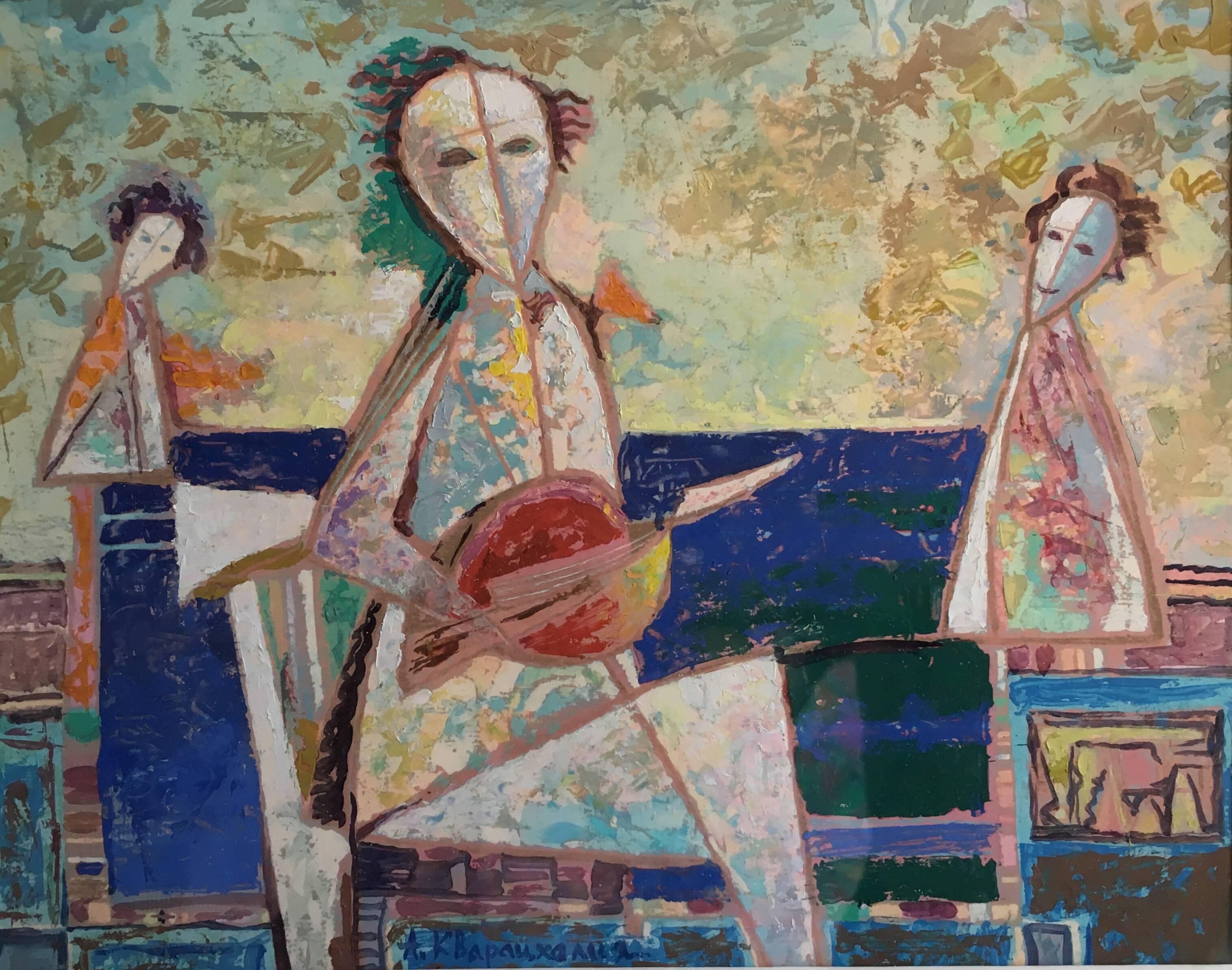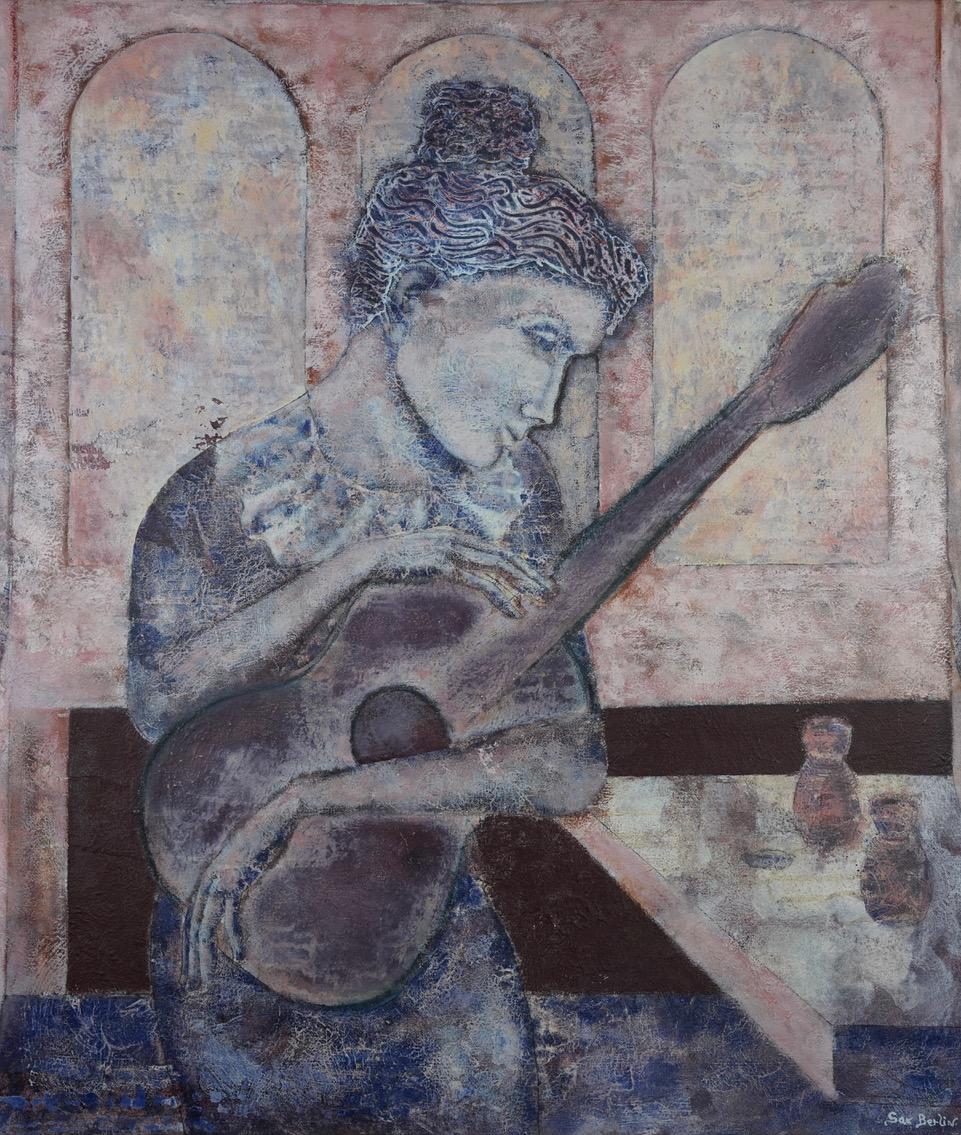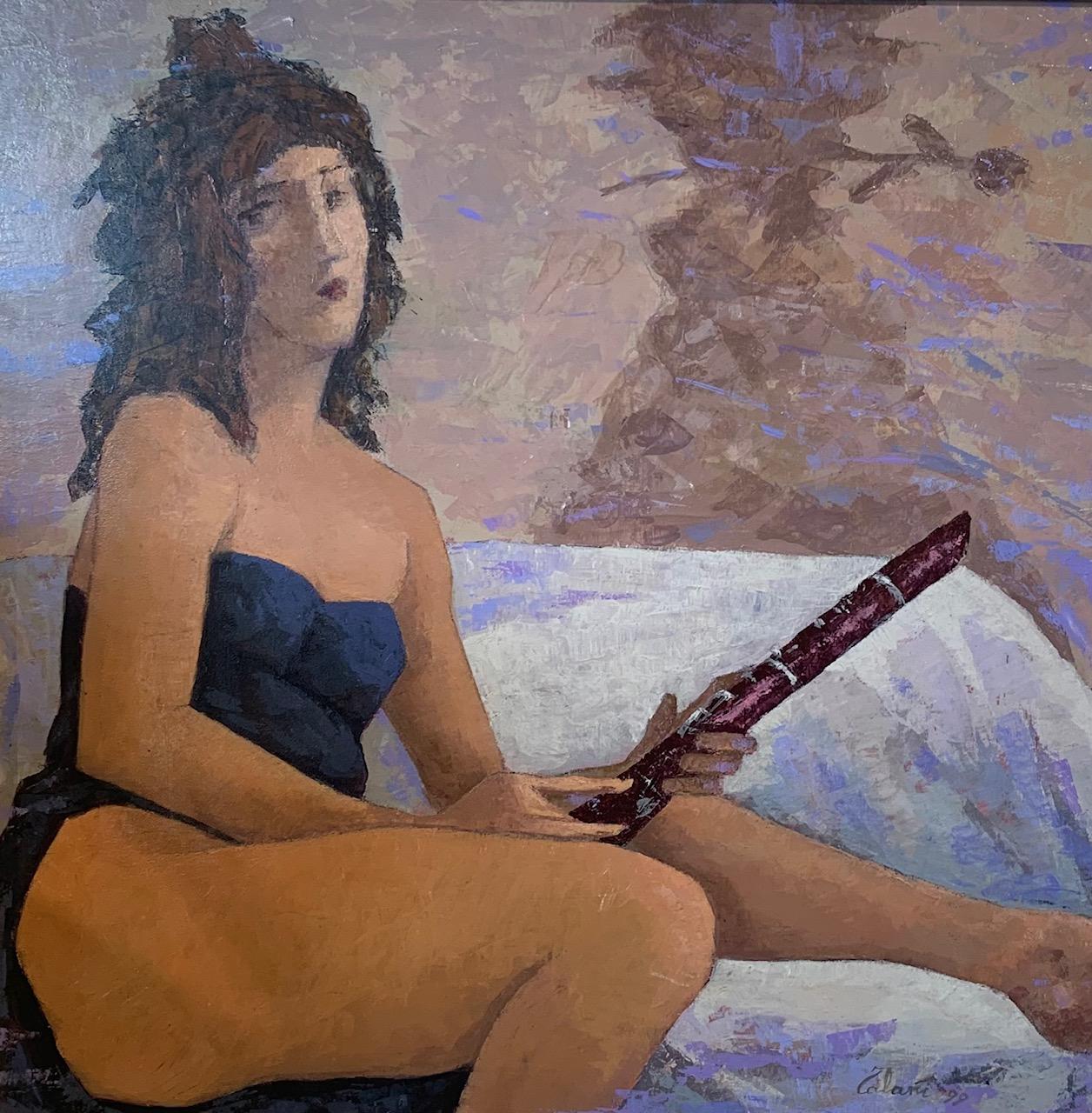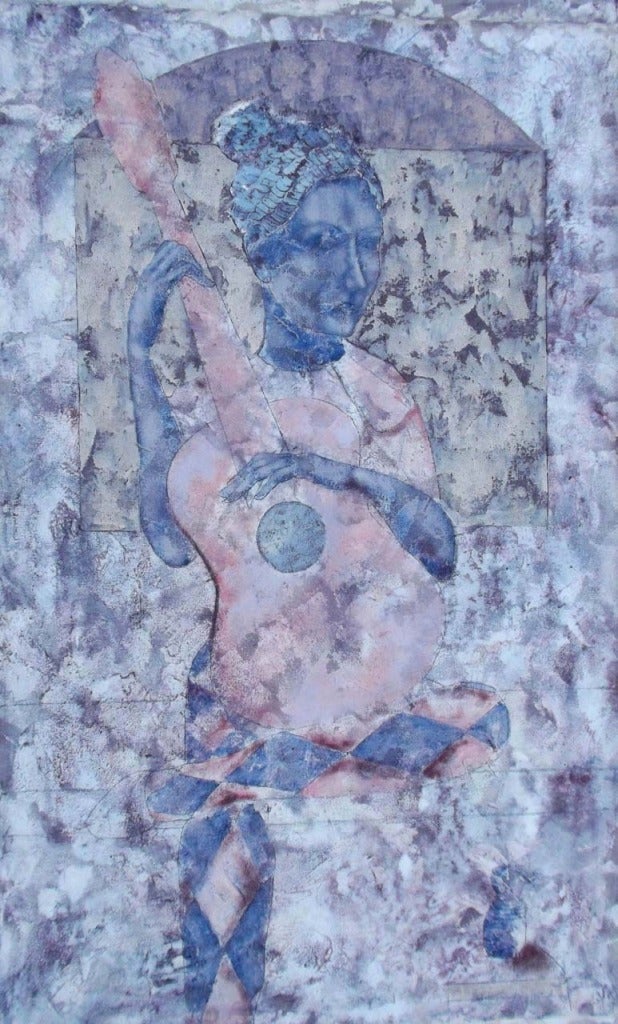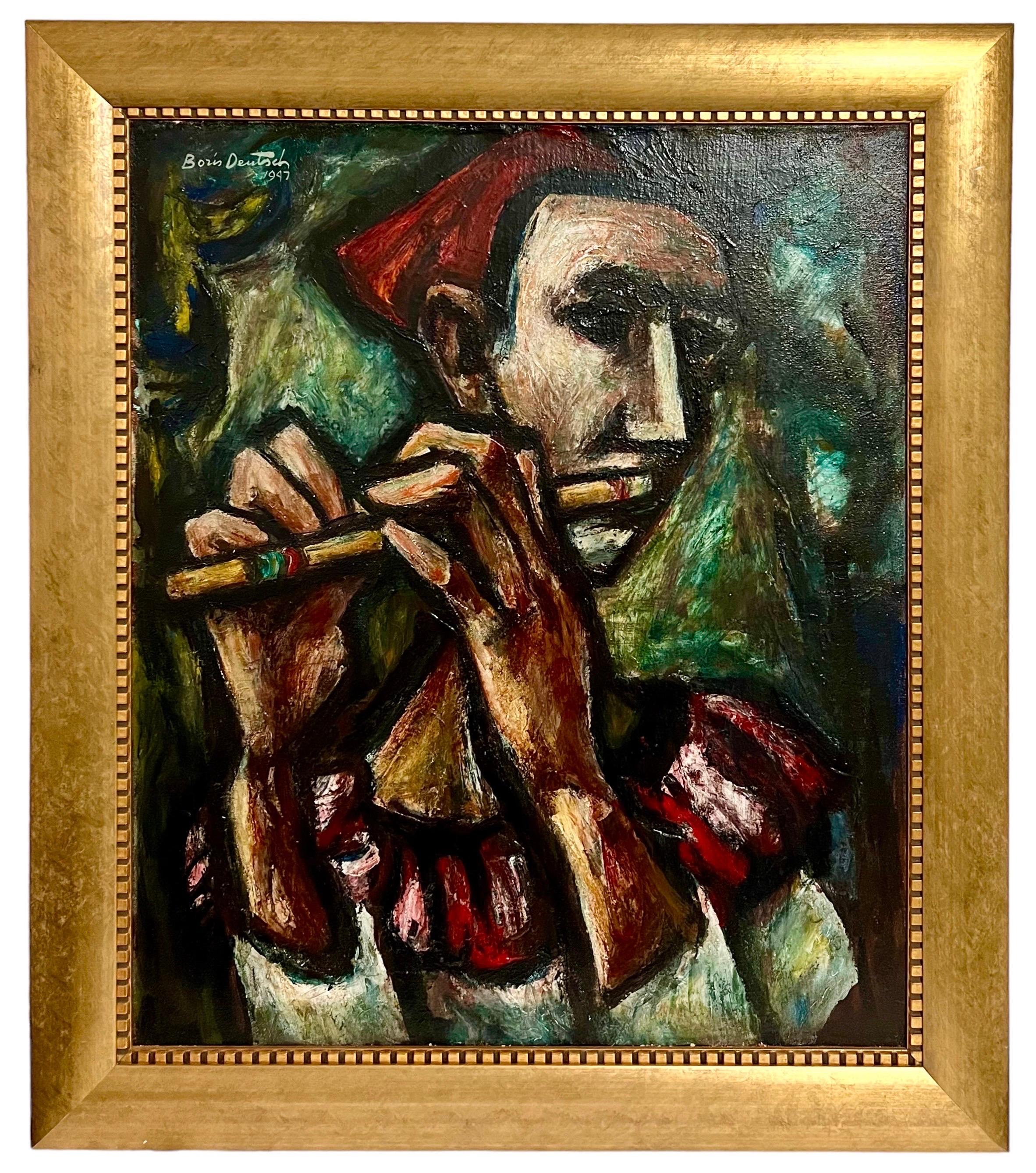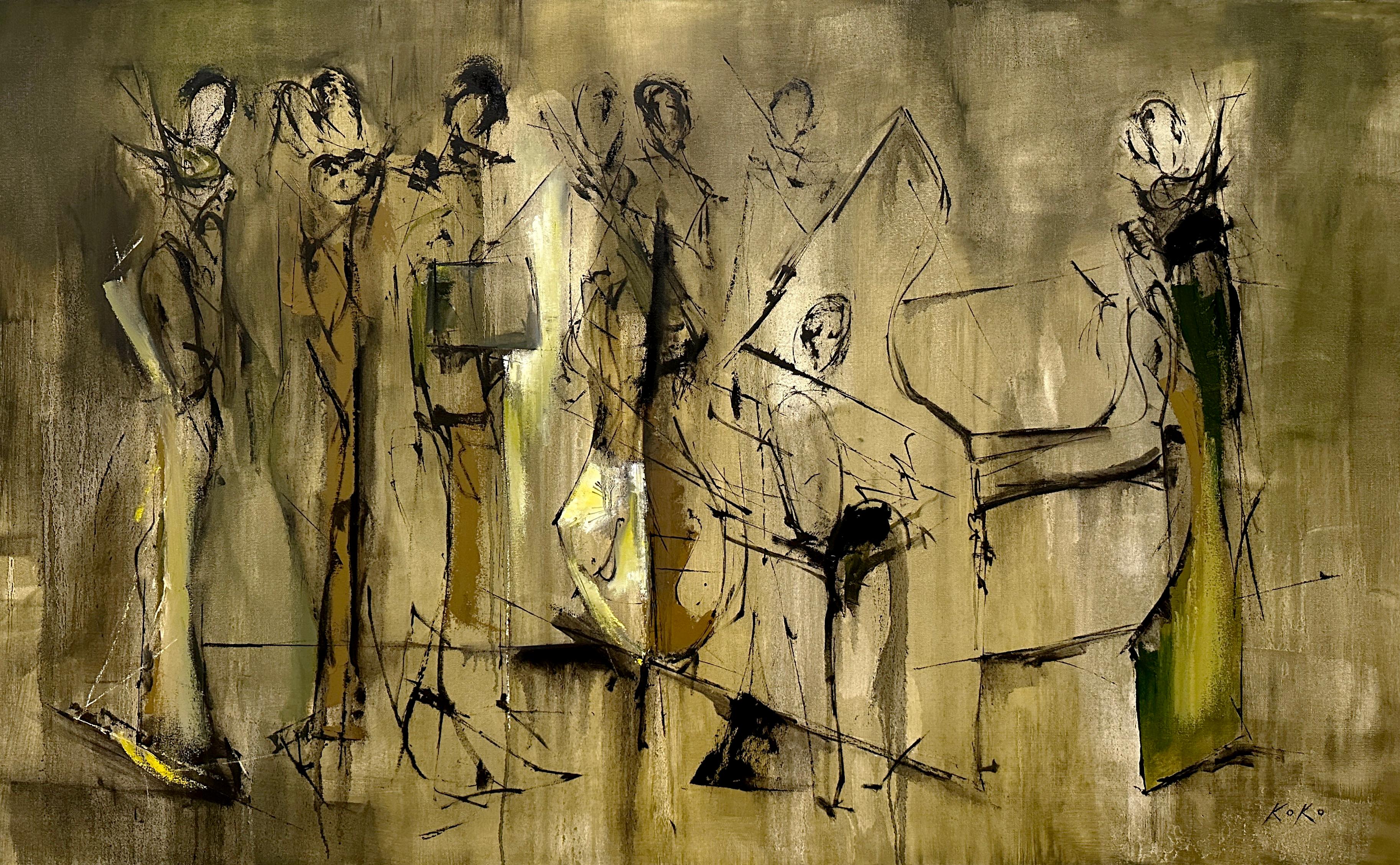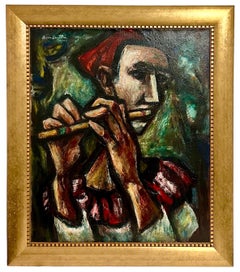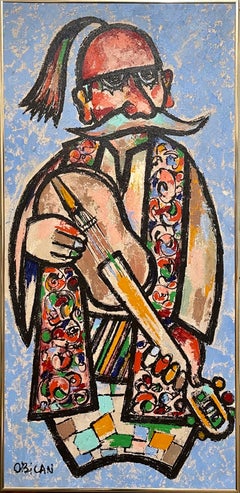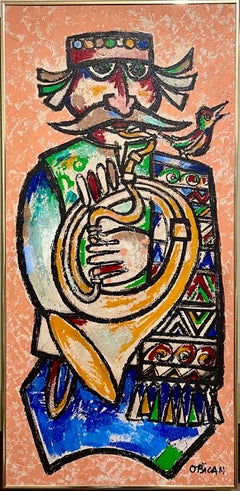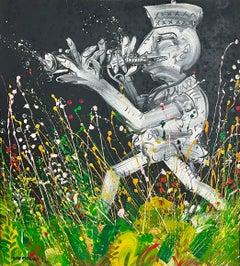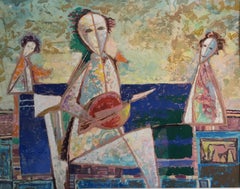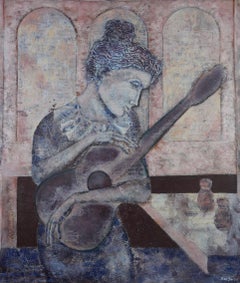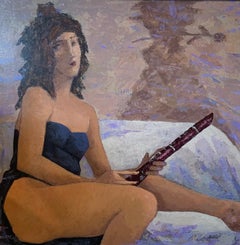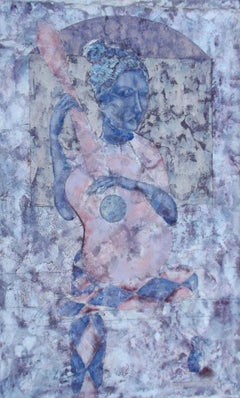Items Similar to The Musician, Large Lating American Modernist Oil Paintng
Want more images or videos?
Request additional images or videos from the seller
1 of 11
Alexis DuqueThe Musician, Large Lating American Modernist Oil Paintng2001
2001
$6,100
£4,585.59
€5,316.15
CA$8,516.55
A$9,538.99
CHF 4,963.45
MX$115,850.31
NOK 62,923.95
SEK 59,373.44
DKK 39,666.06
Shipping
Retrieving quote...The 1stDibs Promise:
Authenticity Guarantee,
Money-Back Guarantee,
24-Hour Cancellation
About the Item
Alexis Duque
Imaginatively charting the psychological experience of space, Alexis Duque produces paintings and drawings of buildings and domestic interiors stacked and conglomerated into trippy, absurd mounds and towers. His compositions are detailed, highly organized, and meticulously architectural. With a psychedelic precision reminiscent of M.C. Escher’s, Duque uses perspectival tricks and surrealistic overlapping to render dozens of skyscrapers as a single red tower; or homes, living rooms, train tracks, and alleys as a mass on the verge of collapsing into itself like a black hole. The wheeling bird’s-eye view that he often employs recalls the Italian Futurists’ soaring imagery of cities as seen from airplanes. Through his playful stacking and piling, he reorders cities to examine the formal properties of their architecture. Alexis Duque holds a Bachelor of Fine Arts from The University of Antioquia, Colombia. His work has been exhibited in numerous venues including: at El Museo del Barrio, The Drawing Center and Praxis International Gallery in New York; The Museum of Latin American Art (MOLAA), Long Beach, CA; Champion Contemporary, Austin, TX; The Alden B. Dow Museum of Science and Art, Midland, MI; RudolfV Gallery, Amsterdam, Netherlands and Galleri Oxholm in Copenhagen, Denmark. Duque’s work has been featured in several publications, including: "Imagine Architecture: Artistic Visions Of The Urban Realm”, “Caribbean: Together Apart Contemporary Artists from (part of) the Caribbean" Imago Mundi - Luciano Benetton, Blue Canvas Magazine, LandEscape Art review, Beautiful Decay, Artistaday, New American Paintings, Studio Visit Magazine, The East Hampton Star, The East Hampton Press and El Diario of New York. Duque currently lives and works in NYC. Less
Education:
B.F.A, University of Antioquia, Colombia, 1995
Exhibitions:
SOLO EXHIBITIONS
•Onloaded: Alexis Duque, curated by Ted G. Decker. Phoenix Institute of Contemporary Art (phICA), Phoenix, AZ, February 20 – March 15, 2015
•Metropolis, Praxis Gallery, New York, NY, September 13- October 20, 2012
•Babel, Praxis Gallery, Miami, FL, September 12 – October 15, 2009
•El Dorado, Praxis Gallery, New York, NY, February 5th – March 12, 2009
SELECTED GROUP EXHIBITIONS
2016
"ARTPRIZE 2016", GRCC Collins Art gallery, Grand Rapids, MI, September 21th to October 9th 2016.
"Paradise in the City" Local Project Art Space, New York, July 14th to August 6th, 2016.
“Shaky Ground” Curated by Dominick Lombardi at Lesley Heller Workspace, New York, NY
"Exquisite Porch" Curated by Dominick Lombardi, Morean Arts Center, St Petersburg, Florida
"The Bronx Speaks: Our Home" Curated by Sarah Corona and presented by the Bronx Arts Alliance in conjunction with New York Armory Arts Week 2016, BronxArtSpace and Andrew Freedman Home, New York.
"Hashtags Unplugged" Caelum Gallery, Chelsea, New York.
2015
“Starting Small” curated by Danielle Gregga, Central Booking Art Gallery, New York, NY
"Map of the New Art" Imago Mundi - Luciano Benetton Collection. Fondazione Giorgio Cini, Island Of San Giorgio Maggiore, Venice, Italy.
2014
"Geometrical Abstraction in New York, A Fresh Look" Curated by Anne Cecile Surga, Sammer Gallery,
New York.
"Concrete Muse" Curated by Krista Saunders, The Dumbo Arts Festival, Brooklyn, NY.
"Global Perspective" a group exhibition held at two New York Locations: Elisa Contemporary Art in
Riverdale, NY and The Eugénia Au Kim Design Studio in Bridgehampton, NY.
"A Creative Oasis" Curated by Ted Decker and organized by phICA-Phoenix Institute of Contemporary
Art, The City Hall of Phoenix, Arizona
"A Different Kind of HOME/SHOW" Curated by Kathy Zeiger, DODDS & EDER HOME, Sag Harbor, NY
"Structured Spaces" Elisa Contemporary Art, Riverdale, NY
"Espora Project" Organized by Masquelibros, (ICP) International Center of Photography Library and Museum
Bookstore, New York, NY
2013
"Sommerudstilling ’13" at Galleri Oxholm, Copenhagen, Denmark
"For Which it Stands" The Lodge gallery, New York, NY
“About Face: New Portraiture Now” Ground Floor Gallery, Brooklyn, NY
“Black Beans/Liquid Gold” Galerie R3I, Berlin, Germany
"Immigrant Too" curated by Gabriel de Guzman at NOMAA, NY
"A House Full of Friends" Curated by Turid Meeker and David Gibson at NOoSPHERE, New York, NY
"Paintings" Galleri Oxholm", Copenhagen, Denmark
"The Architecture of an Idea: Illustrations and concepts", The Alden B.Dow Museum of Science and Art,
Midland, MI.
2012
“Masquelibros” Organized by Tríplica Equipo and the UNED, Madrid, Spain.
“Blind Reproduction” A Gathering of the Tribes, New York, NY
“Puebla Ciudad Mural” Mural Project, Puebla, Mexico.
2011
"El Museo's Bienal: The(S)Files 2011" El Museo del Barrio, New York, NY
"Cluster" AG Gallery, Brooklyn, NY
“Illustrious” Guga Galleries, Newark, NJ
“EastXWestXHarlem” Floor4Art Gallery, New York, NY
2010
“Around the Way” Curated by Rocio Aranda Alvarado and Trinidad Fombella and
organized by Macy’s and El Museo del Barrio, NY
“Interrupted Landscapes” Champion Contemporary, Austin, TX
“Weaving in and Out” No Longer Empty, New York, NY
“Super Cluster” Praxis Gallery, Miami, FL
"Curate NYC" Rush Arts, New York, NY
- Creator:
- Creation Year:2001
- Dimensions:Height: 33.75 in (85.73 cm)Width: 21.75 in (55.25 cm)
- Medium:
- Movement & Style:
- Period:
- Condition:Measurements include frame.
- Gallery Location:Surfside, FL
- Reference Number:1stDibs: LU38211707822
About the Seller
4.9
Platinum Seller
Premium sellers with a 4.7+ rating and 24-hour response times
Established in 1995
1stDibs seller since 2014
1,777 sales on 1stDibs
Typical response time: <1 hour
- ShippingRetrieving quote...Shipping from: Surfside, FL
- Return Policy
Authenticity Guarantee
In the unlikely event there’s an issue with an item’s authenticity, contact us within 1 year for a full refund. DetailsMoney-Back Guarantee
If your item is not as described, is damaged in transit, or does not arrive, contact us within 7 days for a full refund. Details24-Hour Cancellation
You have a 24-hour grace period in which to reconsider your purchase, with no questions asked.Vetted Professional Sellers
Our world-class sellers must adhere to strict standards for service and quality, maintaining the integrity of our listings.Price-Match Guarantee
If you find that a seller listed the same item for a lower price elsewhere, we’ll match it.Trusted Global Delivery
Our best-in-class carrier network provides specialized shipping options worldwide, including custom delivery.More From This Seller
View All1947 Expressionist Oil Painting Flute Player Musician Boris Deutsch WPA Artist
By Boris Deutsch
Located in Surfside, FL
Boris Deutsch (American Lithuanian Russian, 1892-1978)
"The Flute Player," 1947
Oil paint on canvas,
Hand signed and dated upper left,
Provenance: gallery label (Pasadena Art Museu...
Category
1920s Modern Figurative Paintings
Materials
Canvas, Oil
Large Naive European Folk Art Oil Painting Jovan Obican Klezmer Jazz Musician
By Jovan Obican
Located in Surfside, FL
Genre: Other
Subject: People
Medium: Oil
Surface: Canvas
Dimensions: 35" x 16.5
Dimensions w/Frame: 35.5" x 17.25
This depicts a Jazz or Klezmer musician. This one is a banjo or guitar player.
The last photo shows it in a group of three that I have available. This listing is for the one painting.
The artist Jovan Obican iconic style is child-like yet masterfully adult; a style that tells a story with sociological overtones. His funny little people are always colorful, full of spirit, living with music and birds to bring them happiness.
JOVAN OBICAN
Cannes, France, b. 1918, d. 1986
Jovan Obican (1918-1986) artist, painter, sculpture and mosaic ceramic artisan was born in Cannes, France, to his Yugoslavian parents. From childhood on, Jovan practically devoted himself to art, scratching designs into the dirt when paper was unavailable. He trained with many recognized teachers and with many styles. He finished his training, imbued with the spirit of his native country, the people, their legends, and their philosophy. It has been said that his work has a "timeless quality" and a naive, folk art, outsider art brut quality, child-like primitive style. Obican is identified with his style the world over, a style that is simple yet sophisticated; child-like yet masterfully adult; a style that tells a story with psychological, philosophical or sociological overtones. His funny little people are always colorful, full of spirit, living with music and birds to bring them happiness. Best known for his depictions of folklore and traditional costumes rendered in a playful, childlike style and for his happy Jewish wedding scenes. He often used bright colors and black outlines in his renderings of figures and animals, giving his work an illustration-like quality. Thematically, the artist’s work is similar to Marc Chagall and Jean Dubuffet for its dreamlike images and so-called naïve style of painting. Over the course of his career, the artist maintained a studio in Boca Raton, Florida and Dubrovnik, Croatia—part of former Yugoslavia— where he developed an interest in Eastern Europe’s Jewish culture. Many of his mature works depict Jewish traditions and ceremonies, including traditional Jewish weddings, the dancing of the Hora, and traditional music. There is a display of his works in his former Dubrovnik studio.
His style is a unique conglomerate of tradition, history, legends, heroes, old customs and folklore. It is a self-standing style, recognizable, cheerful, whimsical and a happy creation. Naïve art is any form of visual art that is created by a person who lacks the formal education and training that a professional artist undergoes (in anatomy, art history, technique, perspective, ways of seeing). Unlike folk art, naïve art does not necessarily evince a distinct cultural context or tradition. Naïve art is recognized, and often imitated, for its childlike simplicity and frankness. Paintings of this kind typically have a flat rendering style with a rudimentary expression of perspective.
One particularly influential painter of "naïve art" was Henri Rousseau (1844–1910), a French Post-Impressionist who was discovered by Pablo Picasso. Naïve art is often seen as outsider art that is by someone without formal (or little) training or degree. While this was true before the twentieth century, there are now academies for naïve art. Naïve art is now a fully recognized art genre, represented in art galleries worldwide.
Museums devoted to naïve art now exist in Kecskemét, Hungary; Riga, Latvia; Jaen, Spain; Rio de Janeiro, Brasil; Vicq France and Paris. "Primitive art" is another term often applied to art by those without formal training, but is historically more often applied to work from certain cultures that have been judged socially or technologically "primitive" by Western academia, such as Native American, sub saharan African or Pacific Island art (see Tribal art). This is distinguished from the self-conscious, "primitive" inspired movement primitivism. Another term related to (but not completely synonymous with) naïve art is folk art. There also exist the terms "naïvism" and "primitivism" which are usually applied to professional painters working in the style of naïve art (like Paul Gauguin, Mikhail Larionov, Paul Klee).
At all events, naive art can be regarded as having occupied an "official" position in the annals of twentieth-century art since - at the very latest - the publication of the Der Blaue Reiter, an almanac in 1912. Wassily Kandinsky and Franz Marc, who brought out the almanac, presented 6 reproductions of paintings by le Douanier' Rousseau (Henri Rousseau), comparing them with other pictorial examples. However, most experts agree that the year that naive art was "discovered" was 1885, when the painter Paul Signac became aware of the talents of Henri Rousseau and set about organizing exhibitions of his work in a number of prestigious galleries. The Earth Group (Grupa Zemlja) were Croatian artists, architects and intellectuals active in Zagreb from 1929 to 1935. The group included the painters Krsto Hegedušić, Edo Kovačević, Omer Mujadžić, Kamilo Ružička, Ivan Tabaković, and Oton Postružnik, the sculptors Antun Augustinčić, Frano Kršinić, and the architect Drago Ibler. A term applied to Yugoslav (Croatian) naive painters working in or around the village of Hlebine, near the Hungarian border, from about 1930. Some of the best known naive artists are Dragan Gaži, Ivan Generalić, Josip Generalić, Krsto Hegedušić, Mijo Kovačić, Ivan Lacković-Croata, Franjo Mraz, Ivan Večenaj and Mirko Virius. Camille Bombois (1883–1970) Ferdinand Cheval, known as 'le facteur Cheval' (1836–1924) Henry Darger (1892–1973) L. S. Lowry (1887–1976) Grandma Moses, Anna Mary Robertson (1860–1961) Nikifor (1895–1968) Poland, Horace Pippin (1888–1946) Jon Serl (1894-1993) United States Alfred Wallis (1855–1942) Scottie Wilson (1890–1972) Gesner Abelard (b. 1922) Jan Balet (1913–2009) Michel Delacroix (b. 1933) France Howard Finster (1916–2001) Ivan Rabuzin (1921–2008)
Spontaneous Art Museum in Brussels
Art en Marge Museum in Brussels
MADmusée in Liege
International Museum of Naive Art of Brazil...
Category
20th Century Folk Art Figurative Paintings
Materials
Canvas, Oil
Large Naive European Folk Art Oil Painting Jovan Obican Klezmer Jazz Musician
By Jovan Obican
Located in Surfside, FL
Genre: Other
Subject: People
Medium: Oil
Surface: Canvas
Dimensions: 35" x 16.5
Dimensions w/Frame: 35.5" x 17.25
This depicts a Jazz or Klezmer musician. This one is a saxophone or trumpet horn player.
The last photo shows it in a group of three that I have available. This listing is for the one painting.
The artist Jovan Obican iconic style is child-like yet masterfully adult; a style that tells a story with sociological overtones. His funny little people are always colorful, full of spirit, living with music and birds to bring them happiness.
JOVAN OBICAN
Cannes, France, b. 1918, d. 1986
Jovan Obican (1918-1986) artist, painter, sculpture and mosaic ceramic artisan was born in Cannes, France, to his Yugoslavian parents. From childhood on, Jovan practically devoted himself to art, scratching designs into the dirt when paper was unavailable. He trained with many recognized teachers and with many styles. He finished his training, imbued with the spirit of his native country, the people, their legends, and their philosophy. It has been said that his work has a "timeless quality" and a naive, folk art, outsider art brut quality, child-like primitive style. Obican is identified with his style the world over, a style that is simple yet sophisticated; child-like yet masterfully adult; a style that tells a story with psychological, philosophical or sociological overtones. His funny little people are always colorful, full of spirit, living with music and birds to bring them happiness. Best known for his depictions of folklore and traditional costumes rendered in a playful, childlike style and for his happy Jewish wedding scenes. He often used bright colors and black outlines in his renderings of figures and animals, giving his work an illustration-like quality. Thematically, the artist’s work is similar to Marc Chagall and Jean Dubuffet for its dreamlike images and so-called naïve style of painting. Over the course of his career, the artist maintained a studio in Boca Raton, Florida and Dubrovnik, Croatia—part of former Yugoslavia— where he developed an interest in Eastern Europe’s Jewish culture. Many of his mature works depict Jewish traditions and ceremonies, including traditional Jewish weddings, the dancing of the Hora, and traditional music. There is a display of his works in his former Dubrovnik studio.
His style is a unique conglomerate of tradition, history, legends, heroes, old customs and folklore. It is a self-standing style, recognizable, cheerful, whimsical and a happy creation. Naïve art is any form of visual art that is created by a person who lacks the formal education and training that a professional artist undergoes (in anatomy, art history, technique, perspective, ways of seeing). Unlike folk art, naïve art does not necessarily evince a distinct cultural context or tradition. Naïve art is recognized, and often imitated, for its childlike simplicity and frankness. Paintings of this kind typically have a flat rendering style with a rudimentary expression of perspective.
One particularly influential painter of "naïve art" was Henri Rousseau (1844–1910), a French Post-Impressionist who was discovered by Pablo Picasso. Naïve art is often seen as outsider art that is by someone without formal (or little) training or degree. While this was true before the twentieth century, there are now academies for naïve art. Naïve art is now a fully recognized art genre, represented in art galleries worldwide.
Museums devoted to naïve art now exist in Kecskemét, Hungary; Riga, Latvia; Jaen, Spain; Rio de Janeiro, Brasil; Vicq France and Paris. "Primitive art" is another term often applied to art by those without formal training, but is historically more often applied to work from certain cultures that have been judged socially or technologically "primitive" by Western academia, such as Native American, sub saharan African or Pacific Island art (see Tribal art). This is distinguished from the self-conscious, "primitive" inspired movement primitivism. Another term related to (but not completely synonymous with) naïve art is folk art. There also exist the terms "naïvism" and "primitivism" which are usually applied to professional painters working in the style of naïve art (like Paul Gauguin, Mikhail Larionov, Paul Klee).
At all events, naive art can be regarded as having occupied an "official" position in the annals of twentieth-century art since - at the very latest - the publication of the Der Blaue Reiter, an almanac in 1912. Wassily Kandinsky and Franz Marc, who brought out the almanac, presented 6 reproductions of paintings by le Douanier' Rousseau (Henri Rousseau), comparing them with other pictorial examples. However, most experts agree that the year that naive art was "discovered" was 1885, when the painter Paul Signac became aware of the talents of Henri Rousseau and set about organizing exhibitions of his work in a number of prestigious galleries. The Earth Group (Grupa Zemlja) were Croatian artists, architects and intellectuals active in Zagreb from 1929 to 1935. The group included the painters Krsto Hegedušić, Edo Kovačević, Omer Mujadžić, Kamilo Ružička, Ivan Tabaković, and Oton Postružnik, the sculptors Antun Augustinčić, Frano Kršinić, and the architect Drago Ibler. A term applied to Yugoslav (Croatian) naive painters working in or around the village of Hlebine, near the Hungarian border, from about 1930. Some of the best known naive artists are Dragan Gaži, Ivan Generalić, Josip Generalić, Krsto Hegedušić, Mijo Kovačić, Ivan Lacković-Croata, Franjo Mraz, Ivan Večenaj and Mirko Virius. Camille Bombois (1883–1970) Ferdinand Cheval, known as 'le facteur Cheval' (1836–1924) Henry Darger (1892–1973) L. S. Lowry (1887–1976) Grandma Moses, Anna Mary Robertson (1860–1961) Nikifor (1895–1968) Poland, Horace Pippin (1888–1946) Jon Serl (1894-1993) United States Alfred Wallis (1855–1942) Scottie Wilson (1890–1972) Gesner Abelard (b. 1922) Jan Balet (1913–2009) Michel Delacroix (b. 1933) France Howard Finster (1916–2001) Ivan Rabuzin (1921–2008)
Spontaneous Art Museum in Brussels
Art en Marge Museum in Brussels
MADmusée in Liege
International Museum of Naive Art of Brazil...
Category
20th Century Folk Art Figurative Paintings
Materials
Canvas, Oil
Expressionist Judaica French Israeli Modernist Art Oil Painting Rabbi, Musician
By George Chemeche
Located in Surfside, FL
This is a bright, colorful oil painting of a Hasidic Musician in the the holy city of Jerusalem, Israel
1972,
Oil on canvas,
29 X 26 inches
Hand signed and dated.
George Cheme...
Category
1970s Expressionist Figurative Paintings
Materials
Oil
Large Naive European Folk Art Oil Painting Jovan Obican Klezmer Jazz Musician
By Jovan Obican
Located in Surfside, FL
Genre: Other
Subject: People
Medium: Oil
Surface: Canvas
Dimensions: 35" x 16.5
Dimensions w/Frame: 35.5" x 17.25
This depicts a Jazz or Klezmer musician. This one is a bass player.
The last photo shows it in a group of three that I have available. This listing is for the one painting.
The artist Jovan Obican iconic style is child-like yet masterfully adult; a style that tells a story with sociological overtones. His funny little people are always colorful, full of spirit, living with music and birds to bring them happiness.
JOVAN OBICAN
Cannes, France, b. 1918, d. 1986
Jovan Obican (1918-1986) artist, painter, sculpture and mosaic ceramic artisan was born in Cannes, France, to his Yugoslavian parents. From childhood on, Jovan practically devoted himself to art, scratching designs into the dirt when paper was unavailable. He trained with many recognized teachers and with many styles. He finished his training, imbued with the spirit of his native country, the people, their legends, and their philosophy. It has been said that his work has a "timeless quality" and a naive, folk art, outsider art brut quality, child-like primitive style. Obican is identified with his style the world over, a style that is simple yet sophisticated; child-like yet masterfully adult; a style that tells a story with psychological, philosophical or sociological overtones. His funny little people are always colorful, full of spirit, living with music and birds to bring them happiness. Best known for his depictions of folklore and traditional costumes rendered in a playful, childlike style and for his happy Jewish wedding scenes. He often used bright colors and black outlines in his renderings of figures and animals, giving his work an illustration-like quality. Thematically, the artist’s work is similar to Marc Chagall and Jean Dubuffet for its dreamlike images and so-called naïve style of painting. Over the course of his career, the artist maintained a studio in Boca Raton, Florida and Dubrovnik, Croatia—part of former Yugoslavia— where he developed an interest in Eastern Europe’s Jewish culture. Many of his mature works depict Jewish traditions and ceremonies, including traditional Jewish weddings, the dancing of the Hora, and traditional music. There is a display of his works in his former Dubrovnik studio.
His style is a unique conglomerate of tradition, history, legends, heroes, old customs and folklore. It is a self-standing style, recognizable, cheerful, whimsical and a happy creation. Naïve art is any form of visual art that is created by a person who lacks the formal education and training that a professional artist undergoes (in anatomy, art history, technique, perspective, ways of seeing). Unlike folk art, naïve art does not necessarily evince a distinct cultural context or tradition. Naïve art is recognized, and often imitated, for its childlike simplicity and frankness. Paintings of this kind typically have a flat rendering style with a rudimentary expression of perspective.
One particularly influential painter of "naïve art" was Henri Rousseau (1844–1910), a French Post-Impressionist who was discovered by Pablo Picasso. Naïve art is often seen as outsider art that is by someone without formal (or little) training or degree. While this was true before the twentieth century, there are now academies for naïve art. Naïve art is now a fully recognized art genre, represented in art galleries worldwide.
Museums devoted to naïve art now exist in Kecskemét, Hungary; Riga, Latvia; Jaen, Spain; Rio de Janeiro, Brasil; Vicq France and Paris. "Primitive art" is another term often applied to art by those without formal training, but is historically more often applied to work from certain cultures that have been judged socially or technologically "primitive" by Western academia, such as Native American, sub saharan African or Pacific Island art (see Tribal art). This is distinguished from the self-conscious, "primitive" inspired movement primitivism. Another term related to (but not completely synonymous with) naïve art is folk art. There also exist the terms "naïvism" and "primitivism" which are usually applied to professional painters working in the style of naïve art (like Paul Gauguin, Mikhail Larionov, Paul Klee).
At all events, naive art can be regarded as having occupied an "official" position in the annals of twentieth-century art since - at the very latest - the publication of the Der Blaue Reiter, an almanac in 1912. Wassily Kandinsky and Franz Marc, who brought out the almanac, presented 6 reproductions of paintings by le Douanier' Rousseau (Henri Rousseau), comparing them with other pictorial examples. However, most experts agree that the year that naive art was "discovered" was 1885, when the painter Paul Signac became aware of the talents of Henri Rousseau and set about organizing exhibitions of his work in a number of prestigious galleries. The Earth Group (Grupa Zemlja) were Croatian artists, architects and intellectuals active in Zagreb from 1929 to 1935. The group included the painters Krsto Hegedušić, Edo Kovačević, Omer Mujadžić, Kamilo Ružička, Ivan Tabaković, and Oton Postružnik, the sculptors Antun Augustinčić, Frano Kršinić, and the architect Drago Ibler. A term applied to Yugoslav (Croatian) naive painters working in or around the village of Hlebine, near the Hungarian border, from about 1930. Some of the best known naive artists are Dragan Gaži, Ivan Generalić, Josip Generalić, Krsto Hegedušić, Mijo Kovačić, Ivan Lacković-Croata, Franjo Mraz, Ivan Večenaj and Mirko Virius. Camille Bombois (1883–1970) Ferdinand Cheval, known as 'le facteur Cheval' (1836–1924) Henry Darger (1892–1973) L. S. Lowry (1887–1976) Grandma Moses, Anna Mary Robertson (1860–1961) Nikifor (1895–1968) Poland, Horace Pippin (1888–1946) Jon Serl (1894-1993) United States Alfred Wallis (1855–1942) Scottie Wilson (1890–1972) Gesner Abelard (b. 1922) Jan Balet (1913–2009) Michel Delacroix (b. 1933) France Howard Finster (1916–2001) Ivan Rabuzin (1921–2008)
Spontaneous Art Museum in Brussels
Art en Marge Museum in Brussels
MADmusée in Liege
International Museum of Naive Art of Brazil...
Category
20th Century Folk Art Figurative Paintings
Materials
Canvas, Oil
Large Venezuelan Expressionist Oil Painting Diego Barboza Latin American Master
Located in Surfside, FL
Diego Barboza - 1945-2003
Hand signed and dated 1988 Oil on Canvas
Diego Barboza was born the Carabobo street of Maracaibo, Venezuela on February 4, 1945. He was a Venezuelan Neo Figurative Painter who is among the most famous and influential figures in Venezuelan art history. Diego Barboza opened a new chapter in Latin America, beyond the surreal or the magical realism of the Modern Latin American Masters. He created a new language of dislocation and transgression. Personages became distorted to the point that was very exaggerated forms His figures twisted and contorted without losing their presence or their pull. Extremities muscles, and bones burst into an explosive compound of divergent and convergent lines. Through eruptive brushstrokes and fractured outlines. Barboza created a world of illusions.
Barboza was born into a upper-middle-class family. He stopped going to school at 12 years old, and he registered himself at the School of Visual Art in the City of Maracaibo Venezuela. Barboza studied at the School of Visual Arts in Caracas, Venezuela. Barboza began his training as an artist at age 12 in his native Maracaibo when he left formal education to enroll in the then School of Plastic Arts of Zulia, then Julio Arraga School of Plastic Arts, where he was a student in the modeling, collage and Drawing of Angelina Curiel. His first collages, in the sixties, show the influence of American Pop Art. In 1967 he exhibited at the Ateneo de Caracas his series 'Los Ratones', a proposal then 'criticized by critics as unprecedented in Venezuela'. In his tribute to the film "Nosferatu" Friedrich Murnau included 32 drawings as well as two-dimensional objects. In 1968 he moved to London where he studied at the London College of Printing. From that time is his '30 Girls with Nets', an action in which 30 students of the London College of Printing, dressed in black and covered by white nets, toured London public places, behaving naturally. His 'street expressions', which he later called 'poetic actions', symbolized a breakdown of social restraints through unusual behaviors that sought to provoke public reactions. Upon his return to Venezuela in 1973, Barboza continues with this line of work, being recognized as one of the initiators of Venezuelan conceptual art. In the 1980's Diego Barboza turned to painting, the New Venezuelan Figuration. Here belongings and the feminine figure fill the work of that time, in which he embodied his intimacy and daily life through scenes of furnishings and flowers that included objects from his workshop and home. His nudes were made from live model, then to follow the path of distortion resulting in their unmistakable females: a figure that represented their personal way of appreciating beauty. Barboza presented his first individual exhibition at the Centro de Bellas Artes of Maracaibo Venezuela. In 1963, he traveled to London when the Conceptual Art movement started, he had the support of the London New Art Lab Gallery. On March 7, 1970 Barboza displayed his first work on Conceptual Art, which he called Art of Action. In London with the performance of 30 Girls with nets (30 Muchachas con redes). His second work was Nets and Hats in markets and restaurants (Con sombreros y redes en mercados y restaurantes). In London UK. His third The Centerpiece (El Ciempies) and the fourth Expression on a laundry-mat (Expresiones en una lavandería)
In 1974. Baboza returned to Venezuela. Where he presented two very important Conceptual Art works: The Armadillo Box (La Caja del Cachicamo) and from the School of Athens to the New School of Caracas (De la Escuela de Atenas a la Nueva Escuela de Caracas). Closing his cycle of Conceptual Art creation. IN Venezuela a sort of impromptu academy started up at Claudio Perna’s house. Eugenio Espinoza, Roberto Obregón, Antonieta Sosa, Alfred Wenemoser, Yeni and Nan, Sigfredo Chacón, Diego Barboza, Luis Villamizar, Margherita D’Amico, Pedro Terán, Alfredo del Mónaco, as well as international figures who happened to be visiting Venezuela such as Antoni Muntadas, Charlotte Moorman, and Roman Polanski would gather there. Venezuela, especially Caracas, was a rich field of action for modernism in South America. Venezuelan Geometric Abstraction, Op art and Kinetic Art dominated through crucial figures like Jesús Rafael Soto, Gego, Alejandro Otero, and Carlos Cruz Diez, the country’s kinetic art made a fundamental contribution internationally. The Greater London Arts Association and the Arts Council of Great Britain did several exhibitions of (North, Central, South, London, Wales, Scotland and Ulster) to show the actual Visual Arts in all of the United Kingdom and Diego Barboza was invited for this event with a solo exhibition, expressions around a cylinder (Expresiones alrededor de un cilindro).
Diego has made numerous solo and group exhibitions, obtaining rewards since 1963. He is represented in the most important museums of Venezuela, as well as in England, Brazil, Colombia and Cuba. In 1986 he was awarded the Municipal Visual Arts Award of the Municipal Council of the Federal District and in 1997 he received the National Prize for Plastic Arts granted by the National Council of Culture, CONAC.
Select Group Exhibitions
1964 Ateneo de Caracas, Caracas, Venezuela
1965 Salón Arturo Michelena, Valencia, Venezuela
1968 Salón Oficial Museo de Bellas Artes, Caracas, Venezuela
1971 Art Spectrum London, London, Great Britain
1972 Serpentine Gallery, London, Great Britain
1973 Midland Group Gallery, London, Great Britain
1974 Galería BANAP, Caracas, Venezuela
1975 Casa de Las Américas, La Habana, Cuba
Museo de Bellas Artes, Caracas
Galería de Arte Nuevo, Buenos Aires, Argentina
1976 Museo de Arte Moderno, Bogotá, Colombia
Museo de Arte Contemporáneo, Sao Paulo, Brazil
Museo de la Tertulia, Cali, Colombia
Bienal de Venecia, Venecia, Italy
1979 Centro de Artes y Comunicación, Buenos Aires, Argentina
1980 Galería NBC, Memphis, Tennessee, USA
1981 Galería de Arte Nacional, Caracas, Venezuela
Museo de Arte Contemporáneo, Medellín, Colombia
Museo de Bellas Artes, Caracas, Venezuela
1986 Museo de Arte La Rinconada, Caracas, Venezuela
1989 Galería Venzor, Chicago, Illinois, USA
1990 Museo Bellas Artes, Santiago de Chile, Chile
1992 Ambrosino Gallery, Coral Gables, Florida, USA
1993 Museo de Arte de Petare, Caracas, Venezuela
Centro de Arte Lia Bermúdez, Maracaibo, Venezuela
1994 Galería Namia Mondolfi, Caracas, Venezuela
1995 Galería Art Nouveau, Maracaibo, Venezuela
Galería Cesar Sassòn, Caracas, Venezuela
Maremares Resort, Puerto La Cruz, Venezuela
Galería Durban, Caracas, Venezuela
Galería Odalys, Caracas, Venezuela
1996 Centro de Arte Grupo Li, Caracas, Venezuela
Galería Uno, Caracas, Venezuela
Centro Cultural Consolidado, Caracas, Venezuela
Espacios Unión, Caracas, Venezuela
Hebraica, Caracas, Venezuela
1997 Sociedad Dramática, Maracaibo, Venezuela, Venezuela
CELARG, Caracas, Venezuela
Galería Ocre Arte, Caracas, Venezuela
Museo de Arte Contemporáneo , Maracay, Venezuela
Galería Medicci, Caracas, Venezuela
Awards
1963 Premio Estímulo - IX Salón d’Empaire, Maracaibo, Venezuela
1964 Premio José Ortìn Rodríguez - X Salón d’Empaire, Maracaibo, Venezuela
1965 Primer Premio de Dibujo - III Salón Pez Dorado, Caracas, Venezuela
1968 Premio Henrique Otero Vizcarrondo - XXIV Salón Oficial Anual de Arte Venezolano Museo de Bellas Artes,
1973 Premio Emilio Boggio...
Category
1980s Neo-Expressionist Figurative Paintings
Materials
Canvas, Oil
You May Also Like
'Musicians' Surrealist Oil Painting of a Musician, Signed Oil Painting
By Alexei Kvaratskheliya
Located in Cirencester, Gloucestershire
'Musicians' Surrealist Oil Painting of a Musician, Signed Oil Painting
By Russian artist Alexei Kvarayskhelia, 20th Century
Signed by the artist on the lower left hand corner, also labelled on the back
Oil painting on card, framed
Frame size: 16 x 17 inches
Wonderfully stylish and unique oil painting. This surrealist painting of a band...
Category
21st Century and Contemporary Surrealist Abstract Paintings
Materials
Oil
The Musician. Contemporary Figurative Oil Painting
By Sax Berlin
Located in Brecon, Powys
Detailed in this painting are themes dear to Sax Berlin’s heart; music, poetry, and culture, both ancient and modern. There’s a subtle aura of myth and mysticism surrounding this pie...
Category
1990s Contemporary Figurative Paintings
Materials
Oil
The Musician Chime - Figurative Painting by Giampaolo Talani
By Giampaolo Talani
Located in Carmel, CA
Giampaolo Talani (1955-2018)
The "mad scientist" of the art world, Talani created art out of virtually everything he touched. After completing his training at the Florence Academy of...
Category
2010s Contemporary Portrait Paintings
Materials
Oil, Board
"The Guitarist." Contemporary Figurative Oil Painting
By Sax Berlin
Located in Brecon, Powys
A piece of classical beauty painted in Sax Berlin's New York Studio in 1999. She's a study in muted tones, delicately rendered. Gentle, soft and mystical, The Guitarist is an enigmat...
Category
Early 2000s Contemporary Figurative Paintings
Materials
Canvas, Oil
Abstract musicians, musician oil canvas, Monochromatic Musicians , big painting.
By KOKO HOVAGUIMIAN
Located in La Canada Flintridge, CA
Introducing "Monochromatic Musicians - In Deep Green" by the renowned artist Koko Hovaguimian. This captivating oil painting transports the viewer into a world of evocative artistry,...
Category
2010s Abstract Expressionist Figurative Paintings
Materials
Oil
Musicians, Abstract Oil on Board Painting by American Artist John F. Leonard
Located in Long Island City, NY
Musicians (7) by John F. Leonard, American (1921–1987)
Date: circa 1965
Oil on Canvas (unsigned)
Size: 23 in. x 47 in. (58.42 cm x 119.38 cm)
Category
1960s Abstract Figurative Paintings
Materials
Oil, Board
